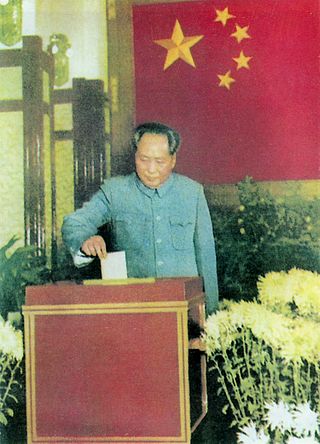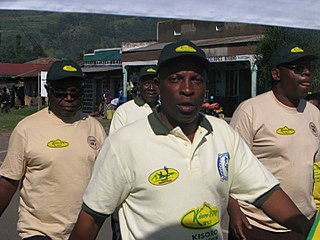This article needs additional citations for verification .(July 2023) |
 |
|---|
A Local Council (LC) is a form of local elected government within the districts of Uganda.
This article needs additional citations for verification .(July 2023) |
 |
|---|
A Local Council (LC) is a form of local elected government within the districts of Uganda.
Uganda has been holding elections consistently since the 1980s, at the different levels including Presidential, Parliamentary, District, and Local Councils. Local Councils are a concept around the lowest political-administrative unit based at the village level.
The District: A district is made up of several counties and any municipalities in that area. A district is led by an elected local council V (LCV) chairperson and his executive. There is also an elected LCV Council, with representatives from the sub-counties and technical staff in the district. The council debates budgets, decisions, and bylaws. On the technical side, the district is led by a Chief Administrative Officer (CAO), appointed by the central government. The district also has heads of various departments such as education, health, environment, and planning, which are responsible for relevant matters in the whole district. Currently, Uganda has about 121 districts that have grown from 30 districts in 1986.
The County: A county is made up of several sub-counties. Each county is represented at the national level in parliament in Kampala by an elected member of Parliament (an MP). In major towns, the equivalent of a county is a municipality (which is a set of divisions). LCIII executive committee members of all the sub-counties constitute the local council IV (LCIV). They then elect an LCIV executive committee from among themselves. These committees have limited powers, except in municipalities, which they run.
The sub-county: The sub-county is made up of a number of parishes and is run by the sub-county chief on the technical side and by an elected local council III (LCIII) chairperson and his/her executive committee, a kind of parliament at that level, complete with a speaker and deputy speaker. The council consists of elected councilors representing the parishes, other government officials involved in health, development and education, and NGO officials in the sub-county. In towns, a sub-county is called a division.
The parish: The parish is the next level up from the village. A parish is made up of a number of villages which could range from five to about ten. Each parish has a Local Council II (LCII) Committee, made up of all the chairpersons from the LCIs in the parish. Each LCII will elect, from among themselves, an executive committee. Today, LCIIs are largely involved in settling land disputes and mobilising the community for various activities. The parish is largely run by a parish chief – a government employee who provides technical leadership to the LCII.
The village: A village usually consists of between 50 and 70 households and may be home to anywhere between 250 and 1,000 people. Each village will be run by a local council – local council I (LCI) - and is governed by a chairperson (LCI chairperson) and nine other executive committee members . Uganda has not held any Local Council elections since 2001(a period of fifteen years, 2001-2017) The 1995 Constitution of the Republic of Uganda, Article 181(4) states that local government elections will be held after every five years. The Electoral Commission had not been able to hold the LC elections when Uganda was still passing off as a one-party system of governance, because it was challenged in the case of Rtd Rubaramira Ruranga Vs Electoral Commission and another in the Constitutional Petition No. 21 of 2006 as inappropriate in a multi-party dispensation.
The delay in holding the election was stated to be due to the high cost involved in holding the election through a secret ballot. Uganda currently has over 60,800 villages, initial budgets indicated that this election would cost over 505bn if it were to be held by secret ballot. Various amendments to section 111 cap 140 of the Local Government Act reduced the cost to 15.9bn through providing for lining behind preferred candidates.
The LC1 elections were eventually conducted on the 10th of July 2018 throughout Uganda which was declared a public holiday to allow voters the opportunity to express themselves. This was after 17 years of not holding the local council elections. As stated in the Local Government Act, A chairperson of a lower government council is among other duties; to be the political head at that level, Preside over the council and executive committee meetings, Monitor the general administration of the area under his or her jurisdiction, oversee the performance of persons employed by the Government to provide services in the council’s area of jurisdiction and to monitor the provision of Government services or implementation of projects in the area under the council’s jurisdiction and also to Perform other functions that may be necessary for the better functioning of the council, or which may be incidental to the functions of the chairperson or imposed on the chairperson by any law.
There are six levels of Local Councils. The lowest level is the Local Council I (LC 1 or LC I) and is responsible for a village or, in the case of towns or cities, a neighborhood. The area covered by Local Councils II through IV incorporates several of the next lowest levels, while a Local Council V (LC5) is responsible for the entire district. In theory, a problem at a local level is relayed up through the various levels until it reaches an LC with sufficient authority or power to resolve it, while centrally planned directives are relayed downward until they are implemented at the local level.
Each Local Council has a certain number of identical positions, such as Chairman, Vice-Chairman, etc. The Local Council does not transfer nationally. Instead, the national government appoints Resident District Commissioners (RDCs) to represent its interests at the district level. [1]

Local government is a generic term for the lowest tiers of public administration within a particular sovereign state. This particular usage of the word government refers specifically to a level of administration that is both geographically localised and has limited powers. While in some countries, "government" is normally reserved purely for a national administration (government), the term local government is always used specifically in contrast to national government – as well as, in many cases, the activities of sub-national, first-level administrative divisions. Local governments generally act only within powers specifically delegated to them by law and/or directives of a higher level of government. In federal states, local government generally comprises a third or fourth tier of government, whereas in unitary states, local government usually occupies the second or third tier of government.

A district is a type of administrative division that in some countries is managed by the local government. Across the world, areas known as "districts" vary greatly in size, spanning regions or counties, several municipalities, subdivisions of municipalities, school district, or political district.

Local government in England broadly consists of three layers: civil parishes, local authorities, and regional authorities. Every part of England is governed by at least one local authority, but parish councils and regional authorities do not exist everywhere. The last comprehensive reform of English local government took place in 1974; since then various piecemeal reforms have taken place, meaning local government is not standardised across the country.
A town council, city council or municipal council is a form of local government for small municipalities.

Local government in The Bahamas exists in two forms, namely second-schedule and third-schedule district councils. There are a total of 32 local government districts: 13 second-schedule districts, which are further sub-divided into town areas, and 19 third-schedule districts, which are all unitary authorities. The second and third schedules together make up the first schedule. Local government policy is formulated and administered by the Department of Lands and Local Government through the Office of the Prime Minister. The day-to-day policy handling of the portfolio falls to the Minister of Local Government who also is empowered to create new local government areas from time to time based on demographics. The administrative and financial management is overseen by the ministry's permanent secretary.

As of 1 July 2020, Uganda is divided into 135 districts plus the capital city of Kampala, which are grouped into four administrative regions.

Elections in the People's Republic of China occur under a one-party authoritarian political system controlled by the Chinese Communist Party (CCP). Direct elections, except in the special administrative regions of Hong Kong and Macau, occur only at the local level people's congresses and village committees, with all candidate nominations preapproved by the CCP.
A municipal council is the legislative body of a municipality or local government area. Depending on the location and classification of the municipality it may be known as a city council, town council, town board, community council, rural council, village council, or board of aldermen.

The counties of Uganda are divided into sub-counties, which are further divided into parishes and villages. The head elected official in a district is the Chairperson of the Local Council V.
Local bodies in Tamil Nadu constitute the three tier administration set-up in the South Indian state of Tamil Nadu. It is a system of local government which forms the last level from the Centre. Chennai Corporation in the then Madras Presidency, established in 1688, is the oldest such local body not only in India but also in any commonwealth nations outside United Kingdom.

The Uganda Local Governments’ Association (ULGA) is the National Association of Local Governments of Uganda. It is a private, voluntary and non-profit body.
Adison Kakuru is a Ugandan politician, businessman, farmer, and environmentalist. He was the elected member of Parliament representing Rukiga County in Kabale District in the 8th Parliament of Uganda. He also served as the elected district chairperson of Kabale District, district council speaker in Kabale, and member of the Kabale District Council representing Rwamucucu Sub-county. He is a member of the National Resistance Movement political party.

The sub-counties of Uganda are divided into parishes, which are further divided into villages. These parishes are governed by a local council II (LCII) committee and parish chief. The parish chief is a government employee that provides technical leadership to the LCII. LCIIs are made up all of the chairmen from the village local council I (LCI) committees in the parish and are responsible for settling land disputes and community outreach.

A gaunpalika is an administrative division in Nepal. The Ministry of Federal Affairs and Local Development dissolved the existing village development committees and announced the establishment of this new local body. It is a sub-unit of a district. There are currently 481 rural municipalities.

Local government in Nepal is the third level of government division in Nepal, which is administered by the provincial governments which in turn is beneath the federal government. Article 56 of the Constitution of Nepal 2015 defines local government as rural municipalities, municipalities and district assemblies.

Sam Byibesho is a Ugandan teacher, public administrator, and politician. He is the elected Member of Parliament for Kisoro Municipality and a representative of National Resistance Movement (NRM), the ruling political party in Uganda. He is a member of the Local Government Accounts Committee, the Committee on Public Service and Local Government, and the NRM Parliamentary Caucus in the 10th Parliament of Uganda.
Rosemary Bikaako Tumusiime is a Ugandan marketing professional, public administrator, feminist and politician. She is the elected Member of Parliament for Entebbe Municipality and is a representative for NRM, the ruling political party in Uganda. She is the first female representative for the constituency in over three decades and succeeded Muhammad Kawuma who served for two consecutive terms from 2006 to 2016. In the 10th Parliament, she serves as a member of the Committee on Equal Opportunities and the Committee on Presidential Affairs. She is also a member of the NRM Parliamentary Caucus, the Buganda Parliamentary Caucusand the treasurer of the Network for African Women Ministers and Parliamentarians (NAWMP).

Lawrence Cherop Mangusho is a Ugandan public administrator, farmer and politician. He is the elected member of parliament for Kween County, Kween District, and a representative for National Resistance Movement (NRM), the ruling political party in Uganda. He is a member the NRM Parliamentary Caucus and serves on the Committee on Physical Infrastructure and the Committee on Government Assurances in the 10th Parliament of Uganda.
A District Development Council is a form of elected local government in Jammu and Kashmir facilitated by the Jammu and Kashmir Panchayati Raj Act, 1989 and created under Jammu and Kashmir Panchayati Raj Rule, 1996 of the constitution of India. They are primarily aimed at electing the members from the rural and urban areas for the District Planning Committee and the councils themselves with fourteen members from each district for speedy development and economic upliftment.
Yovan Adriko is a Ugandan politician and a member of parliament representing Vurra County. He was elected to the parliament on the ticket of National Resistance Movement political party. In the 11th parliament, he serves on the Committee on Public Accounts.